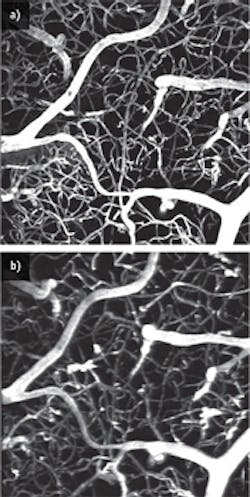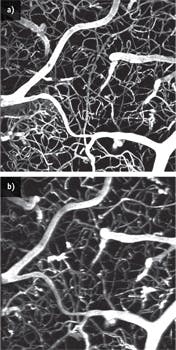HIGH-RESOLUTION MICROSCOPY/FLUORESCENCE IMAGING: Super-sensitive fluorophore facilitates cost-effective two-photon imaging
A new dye could reduce the cost of two-photon microscopy (TPM) by several orders of magnitude, according to researchers who developed it.1 Thus, it could assist neurology: Two-photon microscopy can generate images of active neural structures in much finer detail than can functional magnetic resonance imaging (fMRI). "It's practically the only way to look at individual cells or even sub-cellular structures in the brain at depth," said Sergei Vinogradov, associate professor at the University of Pennsylvania's Perelman School of Medicine. "fMRI gives you only bigger regions; you don't see the details. And a lot of the things we're interested in probing are very close together."
TPM, also known as multiphoton excitation (MPE) imaging, works by shooting a highly focused beam of photons through living tissue. The combined energy of infrared (IR) photons that collide with a molecule of a marker dye causes it to fluoresce. By scanning the beam over a three-dimensional area, the fluorescence can reveal even tiny 3D structures, such as capillaries and individual cells. And by using dyes sensitive to the chemistry of specific processes, such as the movement of calcium ions that allows neurons to fire, the technique can even be used for functional imaging; it can sense changes in neural activity as a subject is thinking.
Dyes currently used for multiphoton microscopy require expensive femtosecond lasers to generate usable imagery. Because nanoparticles made from lanthanide elements are up to 10 million times more excitable than existing molecular dyes, they have long been investigated for use in TPM. But because these nanoparticles aren't soluble, they are not safe to use: Instead of flowing along with the blood, they would sit on the bottom of blood vessels and eventually form clots.
Other groups had tried wrapping the nanoparticles in hydrophilic polymers to increase solubility, but these efforts did not succeed. Vinogradov and his colleagues instead fashioned dendritic polymers with multiple branches attached to a core. "Imagine you have a tennis ball, and you stick it to a Velcro-coated wall. Because it's a ball, there's still a significant fraction of its surface that's still exposed," Vinogradov said. "We take the lanthanide nanoparticles and cover their entire surface with these hydrophilic balls."
Attaching these dendrimers to nanoparticles was made possible by earlier work by Christopher Murray—in Penn's School of Engineering and Applied Science—that enabled a special procedure to "prime-coat" nanoparticle surfaces with a layer that facilitates their interaction with dendrimers. The researchers tested the efficacy of this approach on a mouse model. They started by injecting a conventional marker dye and using a femtosecond laser to map the vasculature of a section of the mouse's brain. They then switched to a laser that was a million times weaker and mapped the same region again, predictably producing no fluorescence. Finally, they kept the same weak laser but injected the dendrimer-coated nanoparticles, which allowed the researchers to produce the same imagery as in the first trial. "This means we did the same experiment as the femtosecond laser but with one that costs hundreds of thousands of dollars less," Vinogradov said.
1. T. V. Esipova, Proc. Nat. Acad. Sci., doi:10.1073/pnas.1213291110 (2012).

